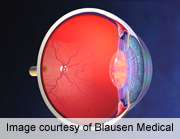Cytomegalovirus-associated posterior uveitis or panuveitis can develop in patients without HIV infection, most of whom have evidence of compromised immune function, according to a study published online March 14 in JAMA Ophthalmology.
(HealthDay)—Cytomegalovirus (CMV)-associated posterior uveitis or panuveitis can develop in patients without HIV infection, most of whom have evidence of compromised immune function, according to a study published online March 14 in JAMA Ophthalmology.
Kessara Pathanapitoon, M.D., Ph.D., from Chiang Mai University in Thailand, and colleagues conducted a retrospective observational study to describe the clinical manifestations and comorbidities of 18 patients (22 eyes) without HIV infection who have CMV-associated posterior uveitis or panuveitis.
The researchers found that all patients exhibited vitreous inflammation. Ocular features included focal hemorrhagic retinitis and peripheral retinal necrosis; in two eyes there were no focal retinal lesions but vasculitis and vitritis were manifested. In 64 percent of the eyes, inflammatory reactions developed in anterior segments. Seventy-three percent of the eyes had retinal vasculitis, including mostly arteries. Eleven patients were taking immunosuppressive medications; one was diagnosed with non-Hodgkin's lymphoma three months after CMV-linked uveitis onset; one had primary immunodeficiency disorder; two had diabetes; and three had no associated systemic diseases and no evidence of immune deficiency.
"CMV-associated infection of posterior eye segments can develop in patients without HIV infection who have variable degrees of compromised immune function but may also occur in individuals who have no evidence of immune insufficiency," the authors write. "It may be that CMV infection located in posterior eye segments of patients without HIV infection is more frequent and has more variable clinical presentation than previously thought."
More information:
Abstract
Full Text (subscription or payment may be required)
Health News Copyright © 2013 HealthDay. All rights reserved.



















